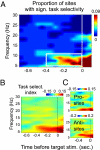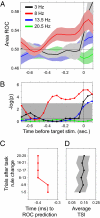Theta-activity in anterior cingulate cortex predicts task rules and their adjustments following errors
- PMID: 20194767
- PMCID: PMC2841867
- DOI: 10.1073/pnas.0906194107
Theta-activity in anterior cingulate cortex predicts task rules and their adjustments following errors
Abstract
Accomplishing even simple tasks depend on neuronal circuits to configure how incoming sensory stimuli map onto responses. Controlling these stimulus-response (SR) mapping rules relies on a cognitive control network comprising the anterior cingulate cortex (ACC). Single neurons within the ACC convey information about currently relevant SR mapping rules and signal unexpected action outcomes, which can be used to optimize behavioral choices. However, its functional significance and the mechanistic means of interaction with other nodes of the cognitive control network remain elusive and poorly understood. Here, we report that core aspects of cognitive control are encoded by rhythmic theta-band activity within neuronal circuits in the ACC. Throughout task performance, theta-activity predicted which of two SR mapping rules will be established before processing visual target information. Task-selective theta-activity emerged particularly early during those trials, which required the adjustment of SR rules following an erroneous rule representation in the preceding trial. These findings demonstrate a functional correlation of cognitive control processes and oscillatory theta-band activity in macaque ACC. Moreover, we report that spike output of a subset of cells in ACC is synchronized to predictive theta-activity, suggesting that the theta-cycle could serve as a temporal reference for coordinating local task selective computations across a larger network of frontal areas and the hippocampus to optimize and adjust the processing routes of sensory and motor circuits to achieve efficient sensory-motor control.
Conflict of interest statement
The authors declare no conflict of interest.
Figures




Similar articles
-
Theta and beta synchrony coordinate frontal eye fields and anterior cingulate cortex during sensorimotor mapping.Nat Commun. 2017 Feb 7;8:13967. doi: 10.1038/ncomms13967. Nat Commun. 2017. PMID: 28169987 Free PMC article.
-
Interareal Spike-Train Correlations of Anterior Cingulate and Dorsal Prefrontal Cortex during Attention Shifts.J Neurosci. 2015 Sep 23;35(38):13076-89. doi: 10.1523/JNEUROSCI.1262-15.2015. J Neurosci. 2015. PMID: 26400938 Free PMC article.
-
Theta-gamma coordination between anterior cingulate and prefrontal cortex indexes correct attention shifts.Proc Natl Acad Sci U S A. 2015 Jul 7;112(27):8457-62. doi: 10.1073/pnas.1500438112. Epub 2015 Jun 22. Proc Natl Acad Sci U S A. 2015. PMID: 26100868 Free PMC article.
-
Contrasting reward signals in the orbitofrontal cortex and anterior cingulate cortex.Ann N Y Acad Sci. 2011 Dec;1239:33-42. doi: 10.1111/j.1749-6632.2011.06277.x. Ann N Y Acad Sci. 2011. PMID: 22145873 Review.
-
Hippocampus as comparator: role of the two input and two output systems of the hippocampus in selection and registration of information.Hippocampus. 2001;11(5):578-98. doi: 10.1002/hipo.1073. Hippocampus. 2001. PMID: 11732710 Review.
Cited by
-
Causal Interactions between Frontal(θ) - Parieto-Occipital(α2) Predict Performance on a Mental Arithmetic Task.Front Hum Neurosci. 2016 Sep 14;10:454. doi: 10.3389/fnhum.2016.00454. eCollection 2016. Front Hum Neurosci. 2016. PMID: 27683547 Free PMC article.
-
Inhibitory Control and Brain-Heart Interaction: An HRV-EEG Study.Brain Sci. 2022 Jun 5;12(6):740. doi: 10.3390/brainsci12060740. Brain Sci. 2022. PMID: 35741625 Free PMC article.
-
An Action-Independent Role for Midfrontal Theta Activity Prior to Error Commission.Front Hum Neurosci. 2022 May 11;16:805080. doi: 10.3389/fnhum.2022.805080. eCollection 2022. Front Hum Neurosci. 2022. PMID: 35634213 Free PMC article.
-
Auditory conflict resolution correlates with medial-lateral frontal theta/alpha phase synchrony.PLoS One. 2014 Oct 24;9(10):e110989. doi: 10.1371/journal.pone.0110989. eCollection 2014. PLoS One. 2014. PMID: 25343503 Free PMC article.
-
Study of the Brain Functional Connectivity Processes During Multi-Movement States of the Lower Limbs.Sensors (Basel). 2024 Oct 31;24(21):7016. doi: 10.3390/s24217016. Sensors (Basel). 2024. PMID: 39517915 Free PMC article.
References
-
- Mansouri FA, Tanaka K, Buckley MJ. Conflict-induced behavioural adjustment: a clue to the executive functions of the prefrontal cortex. Nat Rev Neurosci. 2009;10:141–152. - PubMed
Publication types
MeSH terms
Grants and funding
LinkOut - more resources
Full Text Sources
Other Literature Sources
Molecular Biology Databases
Research Materials

